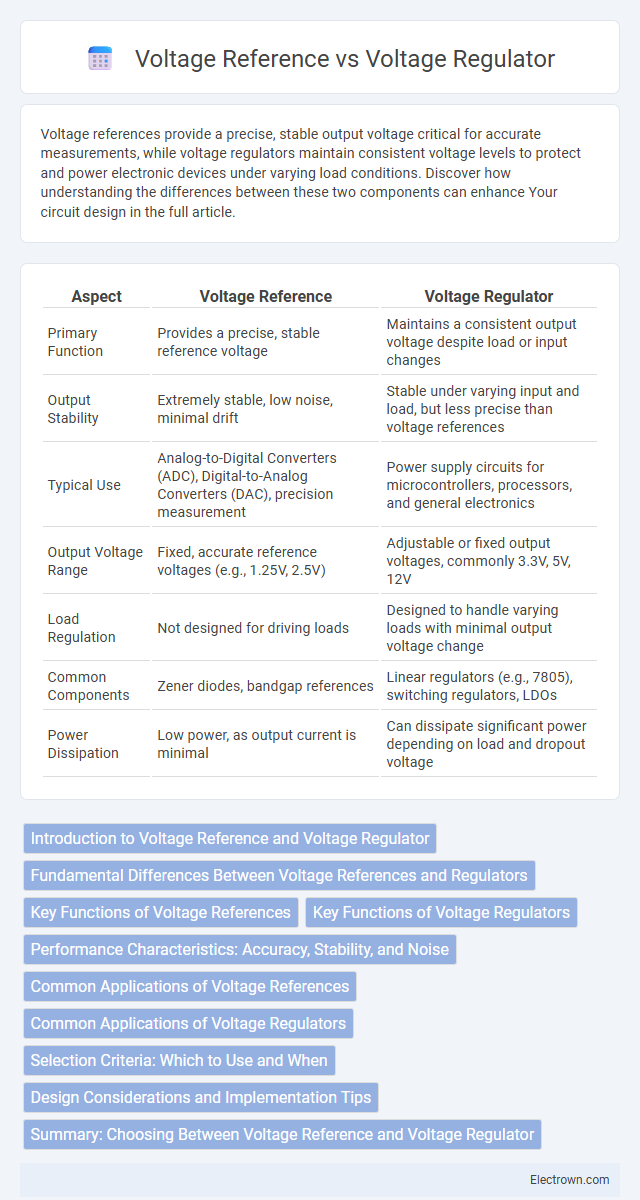Voltage references provide a precise, stable output voltage critical for accurate measurements, while voltage regulators maintain consistent voltage levels to protect and power electronic devices under varying load conditions. Discover how understanding the differences between these two components can enhance Your circuit design in the full article.
Table of Comparison
| Aspect | Voltage Reference | Voltage Regulator |
|---|---|---|
| Primary Function | Provides a precise, stable reference voltage | Maintains a consistent output voltage despite load or input changes |
| Output Stability | Extremely stable, low noise, minimal drift | Stable under varying input and load, but less precise than voltage references |
| Typical Use | Analog-to-Digital Converters (ADC), Digital-to-Analog Converters (DAC), precision measurement | Power supply circuits for microcontrollers, processors, and general electronics |
| Output Voltage Range | Fixed, accurate reference voltages (e.g., 1.25V, 2.5V) | Adjustable or fixed output voltages, commonly 3.3V, 5V, 12V |
| Load Regulation | Not designed for driving loads | Designed to handle varying loads with minimal output voltage change |
| Common Components | Zener diodes, bandgap references | Linear regulators (e.g., 7805), switching regulators, LDOs |
| Power Dissipation | Low power, as output current is minimal | Can dissipate significant power depending on load and dropout voltage |
Introduction to Voltage Reference and Voltage Regulator
Voltage references provide a precise, stable voltage output used as a benchmark in electronic circuits, ensuring accurate measurements and consistent performance. Voltage regulators maintain a constant output voltage despite variations in input voltage or load conditions, protecting sensitive components and improving device reliability. Understanding the distinction helps you select the appropriate component for power management and circuit stability in electronic design.
Fundamental Differences Between Voltage References and Regulators
Voltage references provide a precise, stable output voltage used primarily for accurate measurement and calibration, whereas voltage regulators maintain a constant output voltage despite variations in input voltage or load conditions. The fundamental difference lies in their application: voltage references prioritize accuracy and stability over a narrow current range, while voltage regulators focus on delivering consistent power for varying current demands. Your choice depends on whether you need precise voltage benchmarking or stable power supply management.
Key Functions of Voltage References
Voltage references provide a precise and stable voltage output critical for accurate analog-to-digital conversion, sensor calibration, and measurement systems. Unlike voltage regulators that maintain a constant output voltage under varying load and input conditions, voltage references deliver highly accurate, low-noise, and temperature-stable voltages essential for precision electronics. These components ensure consistent performance in applications requiring stringent voltage stability and minimal drift over time and environmental changes.
Key Functions of Voltage Regulators
Voltage regulators maintain a constant output voltage despite variations in input voltage or load conditions, ensuring stable power supply for electronic circuits. They provide essential protection against voltage spikes and noise, improving device reliability and performance. Unlike voltage references that offer precise fixed voltage for calibration or measurement, voltage regulators actively manage voltage levels to sustain operational stability.
Performance Characteristics: Accuracy, Stability, and Noise
Voltage references offer superior accuracy and long-term stability, essential for precise measurements, with typical accuracy ranging from +-0.1% to +-0.001%. Voltage regulators provide stable output voltage under varying load conditions but generally exhibit lower accuracy and higher noise compared to dedicated voltage references. Your choice depends on whether the application prioritizes noise performance and tight voltage tolerance or robust load regulation.
Common Applications of Voltage References
Voltage references are commonly used in precision measurement instruments, data acquisition systems, and analog-to-digital converters where stable and accurate voltage benchmarks are critical. They provide consistent voltage outputs despite variations in temperature, load, or supply voltage, ensuring reliable performance in calibration equipment and sensor signal conditioning. Unlike voltage regulators that maintain constant voltage supply for power delivery, voltage references are essential in devices requiring exact voltage standards for accurate data processing and control.
Common Applications of Voltage Regulators
Voltage regulators are widely used in electronic devices to maintain a constant output voltage, ensuring stable performance despite variations in input voltage or load conditions. Common applications include power supplies for microprocessors, communication equipment, and battery-powered devices where precise voltage control is critical. Your circuits benefit from voltage regulators' ability to protect sensitive components by preventing voltage fluctuations that could cause malfunctions or damage.
Selection Criteria: Which to Use and When
Voltage references provide highly stable and precise output voltages essential for accurate analog-to-digital conversion and sensor calibration, making them ideal for applications requiring minimal drift and tight tolerance over temperature variations. Voltage regulators, designed to maintain a constant output voltage under varying load and input conditions, are preferred for powering electronic circuits where load current changes are significant. Selection depends on the need for precision and stability versus current capacity and load regulation, with voltage references chosen for precision measurement tasks and voltage regulators for general power supply stability.
Design Considerations and Implementation Tips
Voltage reference circuits prioritize stability and precision to provide a constant voltage regardless of temperature, load, or supply variations, making them essential for accurate measurements and analog-to-digital conversions. Voltage regulators focus on maintaining a consistent output voltage to power devices, requiring careful thermal management and transient response analysis during design to ensure efficient operation. Your implementation should consider choosing between low-dropout regulators for minimal overhead or bandgap references for precise voltage baselines, depending on the application's accuracy and power constraints.
Summary: Choosing Between Voltage Reference and Voltage Regulator
Voltage references provide precise, stable voltage outputs crucial for accurate analog and measurement circuits, while voltage regulators maintain a constant voltage to power electronic devices by compensating for input voltage and load changes. Selecting between the two depends on the application's need for voltage accuracy versus load regulation, with voltage references suited for precision tasks and voltage regulators optimal for consistent power delivery. Key parameters include temperature coefficient, output noise, load regulation, and dropout voltage, which influence performance in specific circuit environments.
voltage reference vs voltage regulator Infographic

 electrown.com
electrown.com